ACU-T: 6100 Particle Separation in a Windshifter using Altair EDEM
Tutorial Level: Beginner
This tutorial introduces you to the workflow for setting up and running a basic sequential coupling (one-way steady) simulation using AcuSolve and EDEM. Prior to starting this tutorial, you should have already run through the introductory tutorial, ACU-T: 1000 Basic Flow Set Up, and have a basic understanding of HyperMesh CFD, AcuSolve, and EDEM. To run this simulation, you will need access to a licensed version of HyperMesh CFD, AcuSolve, and EDEM.
Problem Description


The tutorial consists of two parts:
- AcuSolve simulation
- EDEM simulation
The setup for the AcuSolve simulation is done using HyperMesh CFD. Once the AcuSolve simulation is complete, the velocity nodal data is exported into CGNS format using the AcuTrans utility available in AcuSolve. This field data will be imported into EDEM and will be used to calculate the drag forces on the particles due to the fluid.
Two different bulk materials used in the EDEM simulation and their properties are listed below:
| Name | Density (kg/m3) | Particle radius (m) | Average weight of individual particle (kg) | Rate of generation (particles per sec) |
|---|---|---|---|---|
| Heavy particle | 900 | 0.03 | 0.004 | 100 |
| Light particle | 100 | 0.03 | 0.0004 | 100 |
The fluid drag forces on the particles are calculated using the Schiller-Naumann drag model. The drag force on the particle is calculated using the relative velocity of the particle with respect to the local fluid velocity. This particle body force will used to update the location of the particles and then the new drag forces are calculated. This loop is repeated until the end of the simulation.
Part 1 - AcuSolve Simulation
Start HyperMesh CFD and Open the HyperMesh Database
- Start HyperMesh CFD from the Windows Start menu by clicking .
-
From the Home tools, Files tool group, click the Open Model tool.
Figure 3. 
The Open File dialog opens. - Browse to the directory where you saved the model file. Select the HyperMesh file ACU-T6100_windshifter.hm and click Open.
- Click .
-
Save the database as windshifter_sequential in
the same directory as the other input files.
This will be the working directory and all the files related to the simulation will be stored in this location.
Validate the Geometry
The Validate tool scans through the entire model, performs checks on the surfaces and solids, and flags any defects in the geometry, such as free edges, closed shells, intersections, duplicates, and slivers.

Set Up Flow
Set the General Simulation Parameters
-
From the Flow ribbon, click the Physics tool.
Figure 5. 
The Setup dialog opens. -
Under the Physics models setting:
- Verify that the Incompressible option is selected under Single phase flow.
- Activate the Export geometry to EDEM check-box.
- Set Time marching to Steady.
- Select Spalart-Allmaras as the Turbulence model.
Figure 6. 
- Close the dialog and save the model.
Assign Material Properties
-
From the Flow ribbon, click the Material tool.
Figure 7. 
- Verify that Air has been assigned as the material.
-
On the guide bar, click
 to exit
the tool.
to exit
the tool.
Define Flow Boundary Conditions
-
From the Flow ribbon, Profiled
tool group, click the Profiled Inlet tool.
Figure 8. 
-
Click on the inlet face highlighted in the figure below and enter a value of
20 m/s for the Average velocity in the microdialog.
Figure 9. 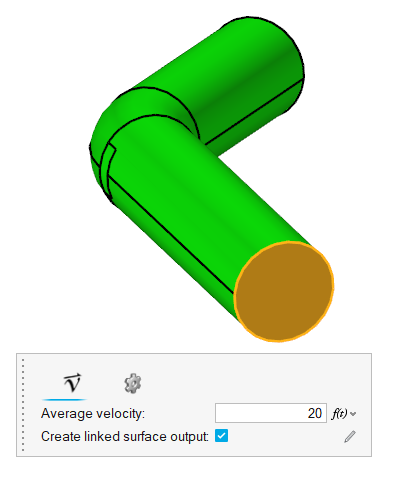
-
On the guide bar, click
 to execute
the command and exit the tool.
to execute
the command and exit the tool.
-
Click the Outlet tool.
Figure 10. 
-
Select the face highlighted in the figure below and then click
 on the
guide bar.
on the
guide bar.
Figure 11. 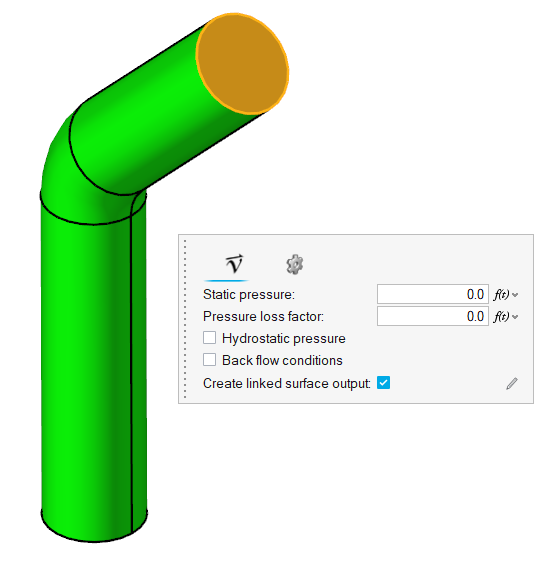
-
Click the No Slip tool.
Figure 12. 
-
Select the face highlighted in the figure below.
Figure 13. 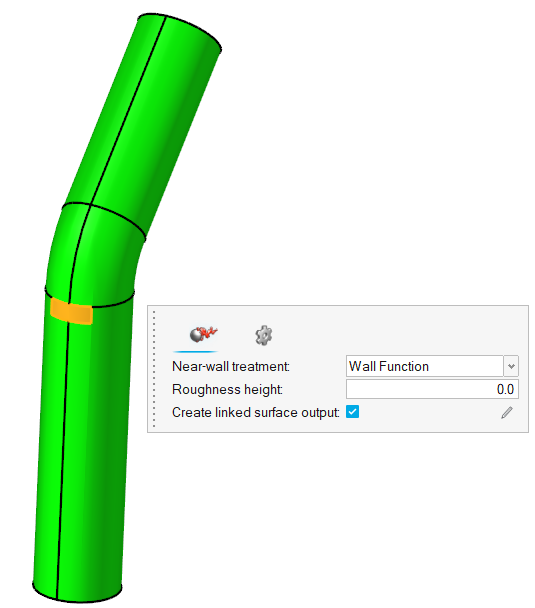
-
In the Boundaries legend, double-click Wall and rename
it to Particle_inlet.
You will use this surface as a reference geometry to create a particle factory in EDEM. Hence, you are placing this surface in a different geometry group.
-
Click
 on the guide bar.
on the guide bar.
- Save the model.
Generate the Mesh
-
From the Mesh ribbon, click the
Volume tool.
Figure 14. 
The Meshing Operations dialog opens.Figure 15. 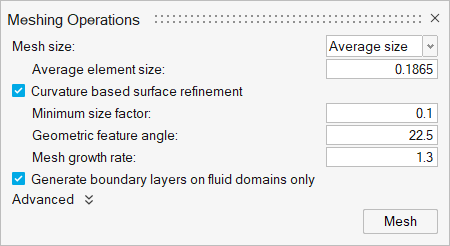
-
Click Mesh.
The Run Status dialog opens. Once the run is complete, the status is updated and you can close the dialog.Tip: Right-click the mesh job and select View log file to view a summary of the meshing process.
- Save the model.
Run AcuSolve
-
From the Solution ribbon, click the Run tool.
Figure 16. 
The Launch AcuSolve dialog opens. - Set the Parallel processing option to Intel MPI.
- Optional: Set the number of processors to 4 or 8 based on availability.
-
Click Run to launch AcuSolve.
Figure 17. 
Once the AcuSolve simulation is launched, HyperMesh CFD also exports the EDEM files which contain the geometry. The surfaces are organized based on the CFD setup.
Export Velocity Field Data
-
From the Solution ribbon, click the
Convert tool.
Figure 18. 
The AcuSolve Data Translator dialog opens. - In the dialog, click Browse, navigate to the AcuSolve problem directory, and open the windshifter_sequential.1.Log file.
- Set the Output format to CGNS.
- Select velocity from the list of variables.
-
Click Convert to export the velocity nodal data in CGNS
format.
Figure 19. 
Once the process is successful, the same information is printed in the Output field and a CGNS file is created in the AcuSolve problem directory.
Post-Process the Results with HM-CFD Post
- Once the solution is completed, navigate to the Post ribbon.
- From the menu bar, click .
-
Select the AcuSolve
.log file in your problem
directory to load the results for post-processing.
The solid and all the surfaces are loaded in the Post Browser.
-
Select the Left face on the view cube to align the model
to the x-z plane.
Figure 20. 
-
In the Post Browser, turn off the display of the boundary
surfaces by clicking the icon next to Flow Boundaries.
Figure 21. 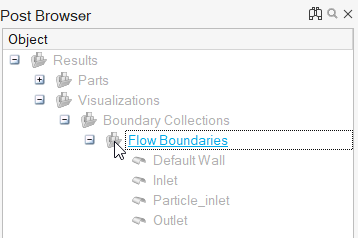
-
Click the Slice Planes tool.
Figure 22. 
- In the modeling window, click on the plane that is parallel to the screen (the x-z plane).
-
In the slice plane microdialog, click
 to
create the slice plane.
to
create the slice plane.
- In the display properties microdialog, set the display to velocity and activate the Legend toggle.
-
Click
 and set the Colormap name to Rainbow
Uniform.
and set the Colormap name to Rainbow
Uniform.
Figure 23. 
-
Click
 on the guide bar.
on the guide bar.
Figure 24. 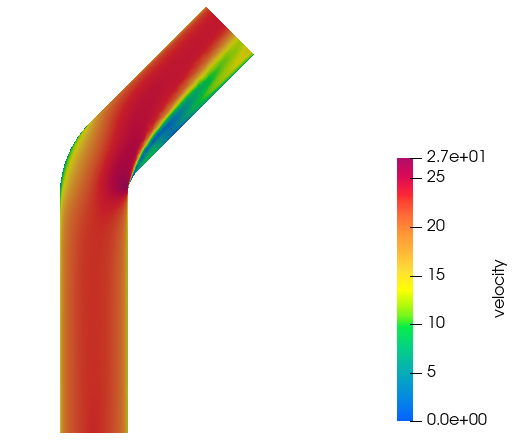
Part 2 - EDEM Simulation
Start Altair EDEM from the Windows start menu by clicking . The user interface in EDEM is divided into three tabs: Creator, Simulator and Analyst. The Creator is used to setup and initialize your model. It is where you import particles and geometries and define the other model parameters. The Simulator is where you configure and control the EDEM simulation engine, and where you can observe the progress of your simulation. The Analyst is the post-processor used to analyze and visualize the results of your simulation.
The steps required to setup and run a basic CFD-DEM one-way coupling are explained below. Refer to the EDEM help documentation for more details.
Open the EDEM Input Deck
As mentioned earlier, when the AcuSolve simulation was launched, HyperMesh CFD created a set of EDEM files in the problem directory. You will open that EDEM input deck and setup the DEM simulation.
- In the Creator tab in EDEM, go to .
-
In the dialog, browse to the AcuSolve problem
directory and open the windshifter_sequential.dem file located in the EDEM
folder.
The geometry is loaded.
-
Click the Environment tab under the Creator Tree,
uncheck Auto Update from Geometry, and then check the box
again to fit the geometry within the boundary.
Figure 25. 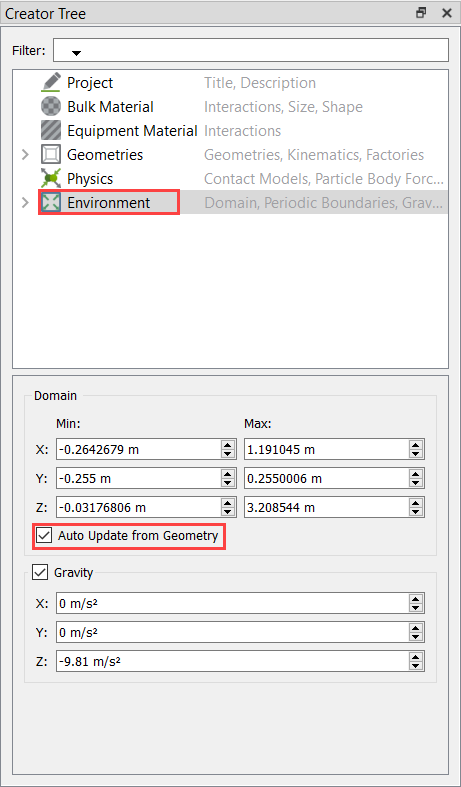
Figure 26. 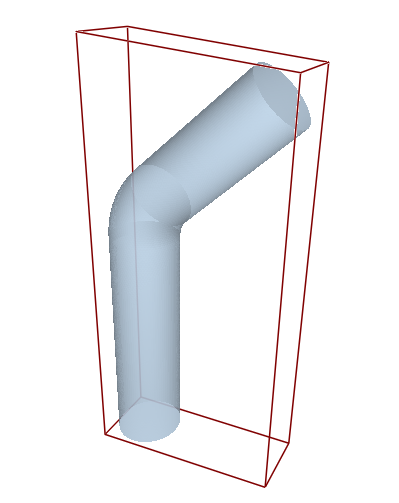
Define the Bulk Materials and Equipment Material
In this step, you will define the material models for the heavy and light bulk material and the equipment material.
- In the Creator Tree, right-click Bulk Material and select Add Bulk Material.
- Rename the material to Heavy.
-
In the Creator Tree, set the Solids Density property to
900 kg/m3.
You will use the default values for other properties for this tutorial.
Figure 27. 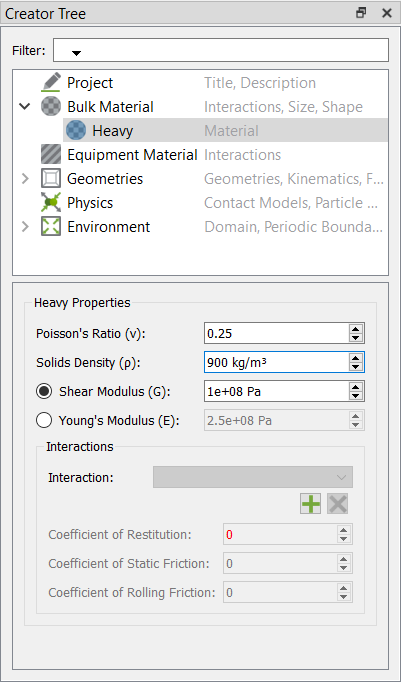
-
Click
 below Interaction to define the
interaction properties for collisions among the heavy particles. In the dialog,
click OK.
below Interaction to define the
interaction properties for collisions among the heavy particles. In the dialog,
click OK.
- In the Creator Tree, right-click Heavy and select .
- Rename the particle to Heavy particle.
- Under Heavy particle, click Properties.
-
In the Heavy particle Spheres panel, set the Physical Radius of both the
spheres to 0.03 m and press Enter.
Figure 28. 
-
In the Creator Tree, click Calculate Properties.
Figure 29. 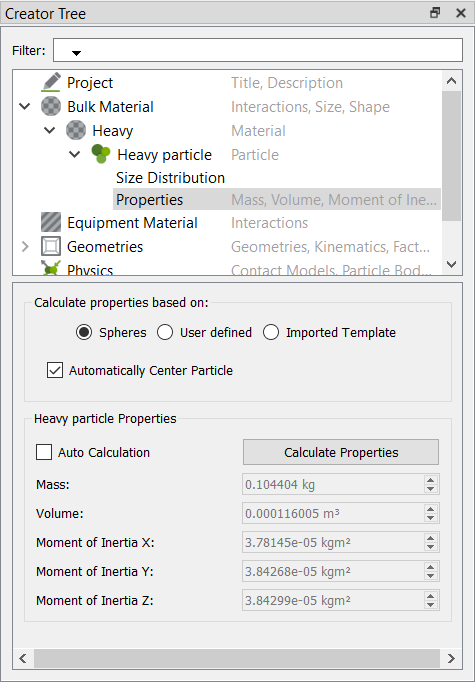
- In the Creator Tree, right-click Bulk Material and select Add Bulk Material.
- Rename the material to Light.
-
In the Creator Tree, set the Solids Density property to
100 kg/m3.
You will use the default values for other properties for this tutorial.
Figure 30. 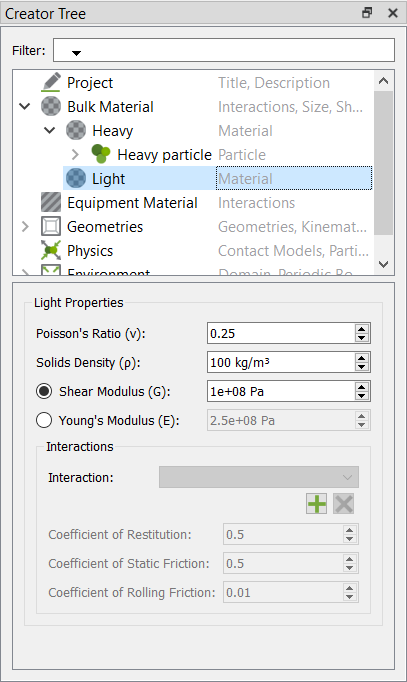
-
Click
 below Interaction to define the
interaction properties for collisions among the heavy particles. In the dialog,
select Heavy and then click OK.
below Interaction to define the
interaction properties for collisions among the heavy particles. In the dialog,
select Heavy and then click OK.
-
Click
 again to define the interaction
properties for collisions among the light particles. In the dialog, select
Light and then click OK.
again to define the interaction
properties for collisions among the light particles. In the dialog, select
Light and then click OK.
- In the Creator Tree, right-click Light and select .
- Rename the particle to Light particle.
- Under Light particle, click Properties.
-
In the Light particle Spheres panel, set the Physical Radius of both the
spheres to 0.03 m and press Enter.
Figure 31. 
-
In the Creator Tree, click Calculate Properties.
Figure 32. 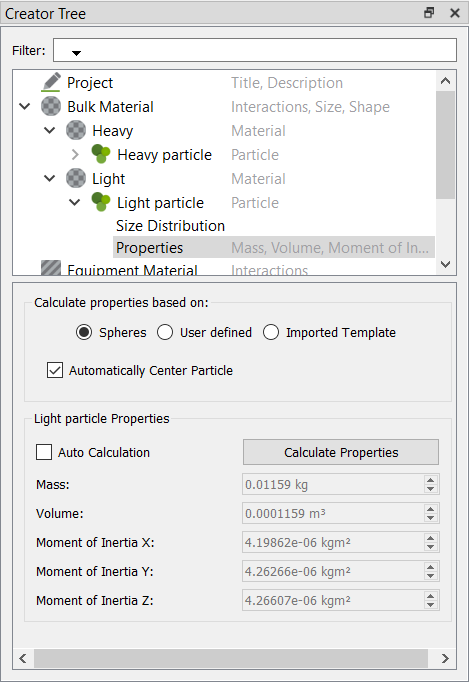
- In the Creator tree, right-click Equipment Material and select Add Equipment Material. Rename it to Steel.
- Set the Density to 7800 kg/m3.
-
Click
 below Interaction to define the
interaction properties for collisions among the heavy particles. In the dialog,
select Heavy and then click OK.
below Interaction to define the
interaction properties for collisions among the heavy particles. In the dialog,
select Heavy and then click OK.
-
Click
 again to define the interaction
properties for collisions among the light particles. In the dialog, select
Light and then click OK.
again to define the interaction
properties for collisions among the light particles. In the dialog, select
Light and then click OK.
- Save the model.
Create the Particle Factory
- Expand Geometries under the Creator Tree tab. Next, right-click the Particle inlet surface group and select .
- Rename the new geometry section to Particle_factory.
- Right-click the Default Wall geometry section in the Creator Tree and select Merge Geometry(s).
- In the Merge Geometry dialog, select the Particle_inlet and then click OK.
-
Click the Default Wall geometry section, set the Type to
Physical, and the Material to
Steel (if not set already).
Figure 33. 
- In the Creator Tree, click the Inlet section and change the Type to Virtual.
- Similarly, change the Type to Virtual for the Outlet and Particle_factory sections.
-
Under Particle_factory, click Transform. Set the
X-Position to 0.035 m.
Figure 34. 
Note: Set the Opacity value to 0.2 to see the transformed surface location inside the pipe geometry.This is done to make sure that the particles are generated inside the fluid domain.
Define the Particle Factory
Now that the bulk material, geometry sections, and equipment materials are defined, you need to create a particle factory to generate the particles. You will create one factory for each bulk material.
- In the Creator Tree, right-click Particle_factory and select Add Factory.
- Rename the new factory to Heavy factory.
-
Set the particle generation parameters as shown in the figure below.
Figure 35. 
-
Click
 besides Velocity, set the
X-velocity to 1 m/s, and then click OK.
besides Velocity, set the
X-velocity to 1 m/s, and then click OK.
- Repeat steps 1-4 to create another factory named Light factory using the same parameters but with Light as the Material.
Define the Physics and Import CFD Field Data
In this step, you will define the physics models for particle collisions and the particle body force.
- In the Creator Tree, click Physics.
-
Click the Interaction drop-down menu and select
Particle Body Force.
Figure 36. 
- Click Edit Contact Chain.
- In the dialog, select the Schiller and Naumann Drag model and then click OK.
-
In the Physics tab, click Schiller and Naumann Drag and
then click
 .
.
-
In the Schiller and Naumann Drag Parameter Values dialog,
enter the values as shown in the figure below and then click OK.
Figure 37. 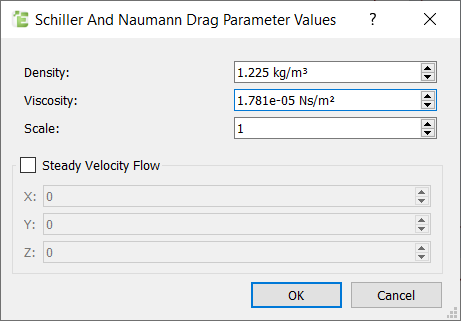
- In the Physics tab, click the Field Data Manager.
-
In the Field Data Manager
dialog, click
 then browse to the AcuSolve problem directory where you saved the CGNS file
exported using the CFD field data. Open
windshifter_sequential_run1.cgns.
then browse to the AcuSolve problem directory where you saved the CGNS file
exported using the CFD field data. Open
windshifter_sequential_run1.cgns.
-
Once the data import is complete, double-click Velocity
and rename it to velocity. (The letter ‘v’ should be in
lower case). Then, close the dialog.
Figure 38. 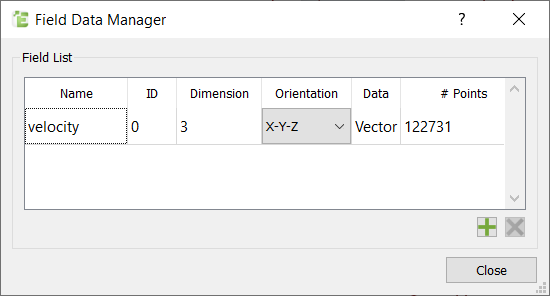
- Save the EDEM deck.
Define the Environment
In this step, you will define the extents of the domain for the EDEM simulation and the direction of gravitational acceleration.
- In the Creator Tree, click Environment.
-
Activate the checkbox for Auto Update from Geometry (if
not already selected).
When a moving particle touches the bounding faces of the domain (environment), it will be removed from the simulation.
- Activate Gravity and set the z-value to -9.81 m/s2.
- Save the EDEM deck.
Define the Simulation Settings and Run the Simulation
-
Click
 in the top-left corner to go to
the EDEM Simulator tab.
in the top-left corner to go to
the EDEM Simulator tab.
- In the Simulator Settings tab, set the Time Integration scheme to Euler and activate the Auto Time Step checkbox (if not set already).
- Set the Total Time to 1 s and the Target Save Interval to 0.01 s.
-
Set the Cell Size to 4 R min.
Generally, a value in the range of 3-6 Rmin is recommended as the optimum cell size. The cell size in EDEM doesn’t have any impact on the accuracy of the simulation and affects only the run time.
-
Set the Selected Engine to CPU Solver and set the Number
of CPU Cores based on availability.
Figure 39. 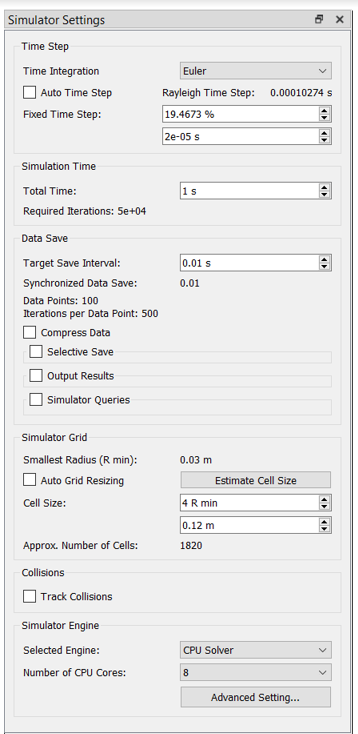
-
Once the simulation settings have been defined, click
 to start the EDEM simulation.
to start the EDEM simulation.
Analyze the Results
-
Once the EDEM simulation is complete, click
 in the top-left corner to go to
the EDEM Analyst tab.
in the top-left corner to go to
the EDEM Analyst tab.
- In the Analyst Tree, expand and then click Default Wall.
-
Verify that the Display Mode is set to Filled and set
the Opacity to 0.2.
Figure 40. 
- In the Analyst Tree, expand Particles and click Heavy particle.
-
Change the display color to Magenta.
Figure 41. 
-
Click Light particle and set the display color to
Green.
Figure 42. 
-
On the menu bar, set the time to
0 by clicking:
Figure 43. 
-
Set the View plane to + Y.
Figure 44. 
-
In the Viewer window, set the Playback Speed to 0.1x
then click on the play icon to play the particle flow animation.
Figure 45. 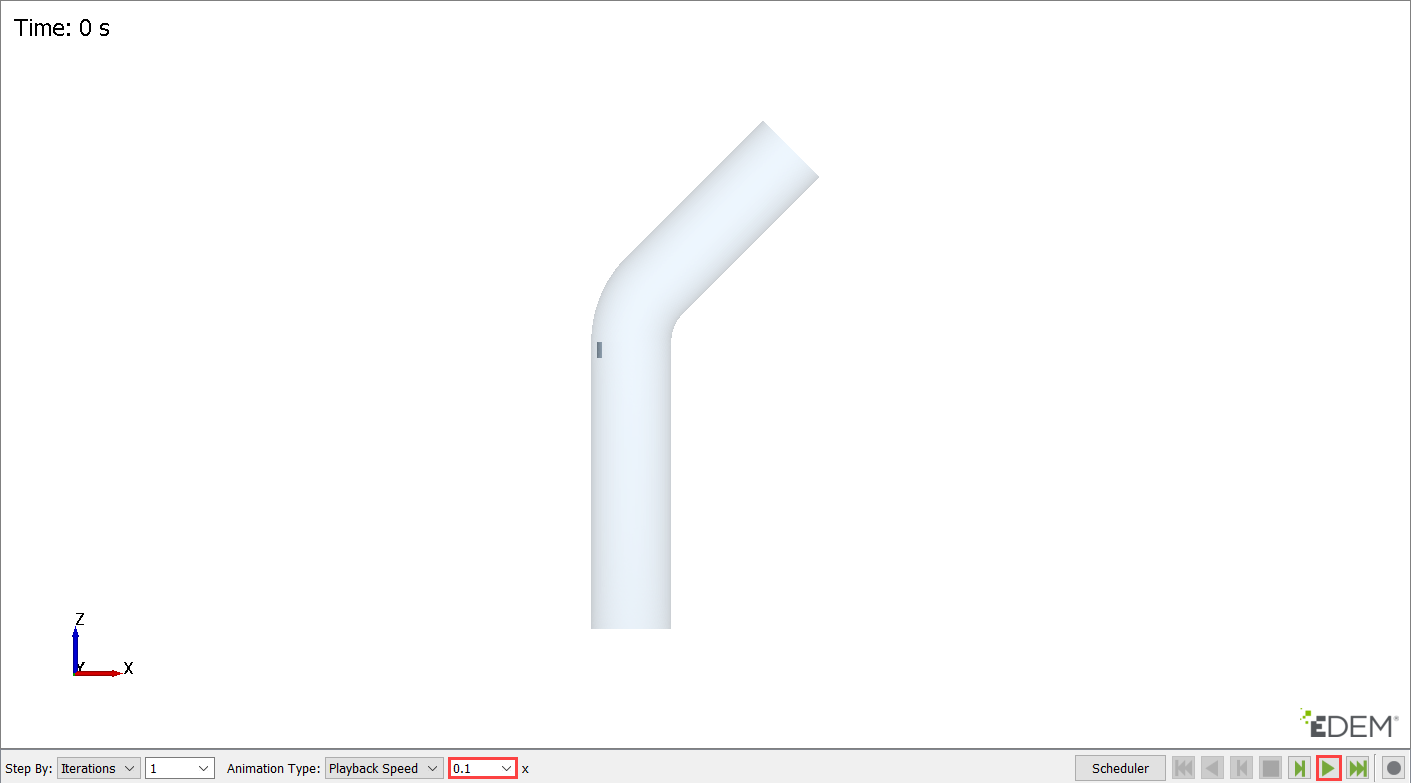
Figure 46. 
Observe that the lighter particles (green) get carried by the fluid and escape the domain through the outlet at the top and the heavier particles (magenta) stay inside the domain for a longer time while some of them fall through the bottom of the pipe.
Summary
In tutorial you learned how to setup a basic AcuSolve-EDEM sequential (one-way steady) coupling problem. In the first part, you set up and solved a steady state flow simulation using AcuSolve and then exported the CFD field data using AcuTrans. Next, you set up the EDEM model and imported the CFD field data using the Field Data Manager. Once the EDEM simulation was completed, you learned how to view results and create animations in EDEM Analyst.